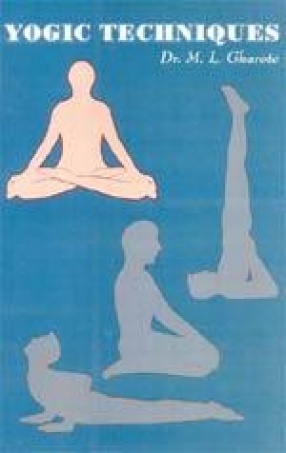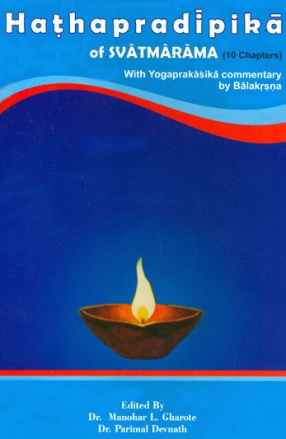
M.L. Gharote

Showing all 17 books














Hatharatnavali is an important text of hathayoga written by Srinivasa, but not widely known as Hathapradipika. The salient features of the text include clear conception of yoga, description of astakarmas, 84 asanas and elaboration on mudras. It also contains philosophical discussion on the pinda-brahmanda (microcosm and macrocosm). While describing the yogic techniques, the author also refers to the old traditions and given new information and techniques, which ...

Like each of the 20 Yogopanisads, these three select Upanisads have elaborated on certain technique/s or issue/s of Yoga which are not easily available in any of the published Hatha literature. Contribution of Yogopanisads lie in their effort to make use of Hatha techniques to achieve the state of Absolute Oneness (Advaita). Advaita theory, which hails ‘the non-dual state or Truth’ to be the Supreme, does not view ‘suffering’ differently ...

For a student of Yoga, Hathayoga provides the practical ground. The traditional of Hathayoga is a valuable gift given by the natha tradition to the world. The culy is deeply rooted in their own philosophical doctrine. goraksanatha was one of the most prominent of the natha siddhas who authored siddha-siddhanta-paddhati. The text chiefly deals with the philosophical doctrines of the natha tradition in a very systematic manner. The book explain the different Layers ...

The text of 'Hathatatvakaumudi is a vast compendium on Hatha system of Yoga practice and philosophy critically edited and published for the first time. The text is authored by Sundaradeva. This work of Sundaradeva poses as extensive and impressive as that of an encyclopedia. Almost all the topics of Hatha Yoga like Asana, Pranayama upto Nadanusandhana in addition to concept of Chayapurusa etc. are described in the minutest of details. There are several unique ...

The teaching of yogic practices is a new experience for students, teachers and beginning teachers alike. This book is intended to sere as a guide to lead from the unknown territory of teaching yoga to the known territory of successful and efficient teaching of yogic practices. It is hoped that it will smoothen the path of the student-teacher or a new teacher of yoga and afford a happier and more profitable learning experience on the part of the yoga ...

The hectic pace of urban life takes its toll of the city-dweller. Both his general health and mental well-being suffer as a result of the strain. This practical book explains in detail the systems of the human body and the techniques of Yoga. The authors show in a step by fashion how it is possible to use Yoga to combat the tensions of a fast paced life and achieve physical and mental tranquility. A special chapter on Yoga and Heart breaks new ground in using the ...

This new edition of the "Encyclopadedia of Traditional Asanas" is being published to satisfy the demand of readers who have, very generously, appreciated the previous edition and expressed the desire that "Encyclopadedia of Traditional Asanas" be made available. Since we have run out of copies of the previous edition, our only option was to publish a new edition.
Needless to say, the aim behind the publication of the Encyclopadedia of ...

This is the first book on the life and contributions of Swami Kuvalayananda in the fields of scientific, literary and therapeutic research in Yoga, Yoga Education and Yogic Therapy. His unique contributions made him a pioneer in the field of scientific Yoga and Indian Physical Education.

This is a 400 years old treatise on Yoga by Bhavadeva Mishra, which contains exhaustive compilation of Yogic principles and practices. This text, though devoid of original Sanskrit text gives all important information of the test in English language. It is a synthesis of various trends in different Yogic traditions.

'Yogic Techniques' deals with both Patanjala Yoga as well as Hathayogic practices. Discussion on the historical perspective of Yoga as an ancient science of self-evolution as well as a system of keeping good overall health proves its practical utility. It provides an in-depth study of the subject though in much a simplified and abridged manner. Techniques of the practices of Hathayoga namely, Asanas, Pranayamas, Kriyas, Bandha-Mudras inclusive of Nadanusandhana ...

Hathapradipika of Svatmarama which has exerted a great influence on the practical student and scholars of Yoga was available only in four chapters until now. It is for the first time that Hathapradipika containing ten chapters is being published along with the Commentary Yogaprakasika by Balakrsna.
It contains additional information on the Pratyahara, Dharana, Dhyana, Samadhi, Kalajnana and Videhamukti. There is a description of sadangayoga along the lines of ...

Glossary of the Yoga Texts was first published in two separate parts in the years of 1997 and 1998. As the interest in Yoga is steadily growing, a serious pursuant of Yoga cherishes a keen interest in delving into the subject. To quench the thirst for knowledge in Yoga, there is no better source than the ancient available texts. However, these texts are not written in a language easily understandable by the modern men. Furthermore, there ...

Kumbhaka Paddhati is the only text dealing exclusively on the topic of Pranayama. It is extensively quoted by sunderadeva, another writer on hatha-yoga in his hatha-sanketa-candrika and hatha-tatva-kaumudi. The text describes more than 50 Kumbhakas, many of which are not commonly known.Despite the description of various kumbhakas, the Author is loud in praise for menu-kumbhakas, the author praises Meru Kumbhaka of which he describes 47 stages. These include all ...

It is a treatise on Yoga belonging to 17th century, which has been critically edited for the first time. It co-ordinates different conflicting views on Yoga and presents synthesis of various trends in different traditions. It contains elaborate chapters on the body and its different systems including 107 Marmas. It has a special chapter on rejuvenation treatment.
